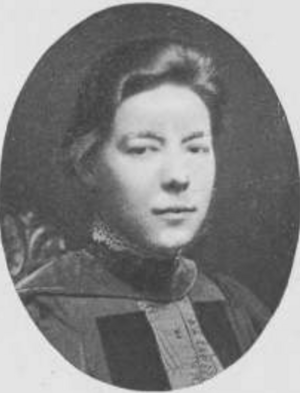Elizabeth Laird (physicist) facts for kids
Quick facts for kids
Elizabeth Laird
|
|
|---|---|

Elizabeth Rebecca Laird, from the 1910 Mount Holyoke College yearbook
|
|
| Born | December 6, 1874 |
| Died | March 3, 1969 (aged 94) |
| Nationality | Canadian |
| Alma mater | University of Toronto, Bryn Mawr College |
| Scientific career | |
| Fields | Physics |
| Institutions | Mount Holyoke College, Cavendish Laboratory |
| Thesis | The absorption spectrum of chlorine (1901) |
| Doctoral advisor | A. S. MacKenzie |
Elizabeth Rebecca Laird (born December 6, 1874 – died March 3, 1969) was an amazing Canadian scientist. She was a physicist, which means she studied how the world works, from tiny atoms to huge galaxies.
Elizabeth Laird led the physics department at Mount Holyoke College for almost 40 years. She was also the first woman allowed to do research at the famous Cavendish Laboratory at Cambridge University. This was a big deal because it was run by Sir J. J. Thomson, a very important scientist.
She finished school in London in 1893. Then she went to the University of Toronto. Even though she was very smart, she couldn't get a special scholarship to study abroad because she was a girl. But she didn't give up! She earned her Ph.D. (a very high degree) in physics and math from Bryn Mawr College in 1901.
Later, a small planet called an Asteroid was named (16192) Laird in her honor.
Contents
Elizabeth Laird's Life and Learning
Early Years and Education
Elizabeth Laird was born in Owen Sound, Ontario, on December 6, 1874. Her mother was Rebecca Laird, and her father was Reverend John Laird, a Methodist minister.
In 1893, Elizabeth finished high school at the London Collegiate Institute. She then went to University College at the University of Toronto. In 1896, she earned her first degree in math and physics. She even won the University's Gold Medal for being an excellent student.
After that, she taught for a year at the Ontario Ladies' College. In 1898, she received a special scholarship to study physics at Bryn Mawr College. She also studied in Germany at the Humboldt University of Berlin from 1898 to 1899. There, she worked with famous scientists like Max Planck and Emil Warburg. She was the first person to use a special light called a Nernst lamp for a physics project.
Elizabeth earned her Ph.D. in physics and math from Bryn Mawr College in 1901. Her research was about spectroscopy (studying light) and magnetism. She also studied at other top universities, like the Cavendish Laboratory in England and the University of Chicago in the USA. Later, she received special honorary degrees from the University of Toronto in 1927 and the University of Western Ontario in 1945.
Her Work as a Scientist
Leading the Physics Department
In 1901, Elizabeth Laird started working at Mount Holyoke College as an assistant in physics. She quickly moved up! The next year, she became an instructor. By 1903, she was made the head of the entire Physics Department.
She was the first woman that Sir J. J. Thomson allowed to do research at the Cavendish Laboratory at Cambridge University. This was a very important place for physics research. She worked there until she retired in 1940.
Research During Wartime
Elizabeth Laird came out of retirement during World War II to help her country. She researched radar at the University of Western Ontario for the Canadian National Research Council. Radar is a system that uses radio waves to find objects, like planes or ships.
She worked without pay, helping with important experiments. She even worked in cold buildings to test equipment. Elizabeth wrote many secret reports about her findings for the National Research Council. She also taught army and navy personnel about radar.
In 1945, she became an honorary professor of physics at the University of Western Ontario. She continued to study how microwave radiation affects living things. This research was supported by a cancer research foundation.
When she retired for the second time in 1953, she was one of Canada's most respected physicists. She was also the oldest working physicist in Canada at that time. Another physicist, A.D. Misener, said that Elizabeth Laird was a great researcher and an inspiring teacher.
Elizabeth Laird passed away on March 3, 1969, in London, Ontario.
Awards and Special Recognitions
Elizabeth Laird received many honors and awards throughout her life.
- She received a special Fellowship from Bryn Mawr College in 1897.
- She was given the President's European Fellowship in 1898-99 to study in Europe.
- She became a Fellow of the American Physical Society, a group for top physicists.
- She was a Sara Berliner Research Fellow in Würzburg in 1913-14.
- She was an Honorary Research Fellow at Yale University in 1925-26.
- She received an honorary Doctor of Science (D.Sc.) degree from Toronto University in 1927.
- She received an honorary Doctor of Laws (LL.D.) degree from Western Ontario University in 1945.
Two special lecture series are named after her:
- The Annual Laird Lecture at the University of Western Ontario, started in 1970.
- The Elizabeth R. Laird Lecture at Memorial University.

